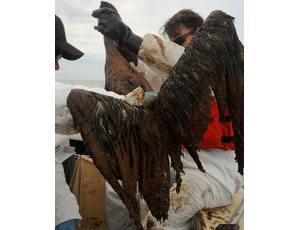As Louisiana prepares to build sand berms along its barrier islands, a $ 360-million project that BP will pay for, the state of Texas’ General Land Office has dismissed reports of oily critters on the Texas Gulf Coast as “media hype.” But concerns remain about the toxicity of dispersants and effects of a hurricane.

Oiled birds and sea turtles did show up on coastlines as the oil came ashore, but reports of oil-soaked birds on Texas shores, which circulated last week, were due to a “clerical error,” a U.S. Coast Guard spokesman says.
“Everyone is looking for an impact, everyone is looking for these birds,” says Texas Land Commissioner Jerry Patterson, head of The Austin-based agency responsible for coordinating Texas efforts associated with the April 20 Deepwater Horizon oil spill in the Gulf of Mexico.
“Birds can fly long distances,” says Piers Chapman, head of the Department of Oceanography at Texas A&M University, College Station, Texas. “It is hard to know where the bird is from, and once covered with oil their ability to fly is affected.”
Donald M. Baltz, a professor in the Department of Oceanography and Coastal Sciences at Louisiana State University, Baton Rouge, says birds have homing instincts and will go back to where they were—particularly if they were nesting. That means they could return to an oily habitat only to be cleaned again, he says.
Baltz says it’s easy to tell if a bird is covered with “brown, sticky stuff like those seen in Louisiana,” but less obvious is what may not be seen.
Baltz adds that while birds are visible, but there are “other animal victims we may never know about.”
There are reports of mammals such as dolphins washed up onshore, but it is unclear if they died because of oil. “Even NOAA [National Oceanic and Atmospheric Administration] doesn’t know,” Chapman says. He says there are more dolphins stranded by the oil slick than have been found onshore.
If the oil does get to Texas, the material will be aged, Baltz says. A lot of the toxic components will have dispersed. The resulting “tarballs” are a nuisance but less likely to be harmful, he says.
“They don’t have to be toxic per se to do harm,” Baltz adds. “A large mass [of tarballs] could come ashore and smother the shoreline and marshes.”
Baltz says a hurricane of any size could move the slick in most any direction.
“If a hurricane did head west, it would not be good news for Texas,” he says.
Baltz adds that whatever happens to Louisiana, the “center of fertile fisheries in the Gulf of Mexico,” also affects the fisheries in Texas.
Ken Medlock, a fellow in energy and resource economics at Houston’s Rice University, is not as concerned about Texas’ fishing industry. He says that equipment suppliers that support the drilling of the well are more at risk. “This is not just about big oil. It’s about service companies—suppliers of equipment, valves, cement.” Texas is where most of these firms are based, and that is where the state will be affected the most, he says.


Post a comment to this article
Report Abusive Comment